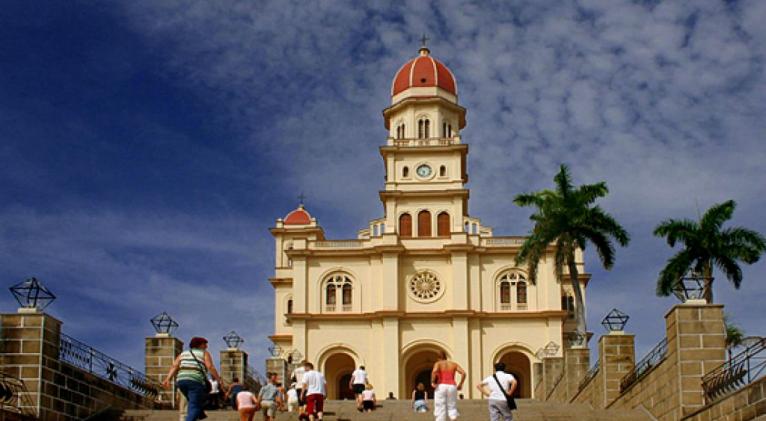Basilica El Cobre: History, Rituals, and Legends

Santiago de Cuba treasures attractive, wonderful, historical, patrimonial, and cultural places that increase Cuba’s reputation. Its citizens share this emotional and friendly feeling intrinsic to the people of this land.
The National Shrine Basilica of Our Lady of Charity of El Cobre excels among many others since it gathers thousands of visitors each year from all around the country and other places of the world. The Basilica has gained greater visibility these days because Pope Francis will celebrate a Mass there next September 22nd.
In a trip to Santiago de Cuba, when you go by El Cobre, 22 km away from the country’s second largest city, the church looks like a postcard embedded in the mountains, thanks to its natural beauty, and such tangible and spiritual heritage that make it unique.
During his visit to the island in 1998, the Pope John Paul II crowned and praised the image of the Virgin in the third mass he celebrated in Cuba, held in the Revolution Square Antonio Maceo, on January 24th.
On March 26th, 2012, Pope Benedict XVI awarded the city with the Golden Rose on the occasion of the ceremony for the 400th anniversary of the finding of the Virgin of the Charity’s image.
With the arrival of Pope Francis on September 21st, the sanctuary will become one of the few privileged places in the world to have welcomed the last three Popes.
The Bishop of Rome will find a respectful, noble, and helpful people. Cuba has also had magnificent men who showed huge love for the country and God, and they were examples of the Cuban ethnicity: Father Varela, Jose de la Luz y Caballero, and Jose Agustin Caballero.
El Cobre settlement gained prominence in the years 1604-1613 after two Indians and a Creole Negro found the image of the Virgin of the Charity floating at the North Eastern Sea of Cuba.
The episode, narrated under Ecclesiastic oath by Juan Moreno, known as “el negrito de La Caridad (the little negro of the Charity)”, tells the story of how he and two of his Indian brothers (Juan and Rodrigo de Hoyos) were in a canoe looking for salt. When they were leaving the French Key (Nipe Bay) they saw something floating at the sea and much to their surprise, they realized it was the Virgin of the Charity image.
From that moment on, the worship fused with the spirituality of native people and transcended the whole country.
According to old documents kept at the General Archive of the Indies, the arrival of the image of the Virgin of Charity (Virgen de la Caridad) in the mountain range of El Cobre took place when artillery captain Francisco Sanchez de Moya received a mandate from King Philip II in May 1597 commanding him to go to the mines to defend those coasts from the attacks of British pirates.
Following those events, the king ordered him to build a small church, where soldiers and miners could go to entrust themselves and to pray to the venerated image.
The Sanctuary of El Cobre is one of the most revered religious sites by the Cuban people.
Coming from different territories of the nation, believers seek the spiritual comfort, the solution to their longings and problems that affect humans.
It is said that in 1915 the veterans of the War of Independence wrote to Pope Benedict XV requesting him to proclaim the Virgin of Charity as Patroness of Cuba, and this came true on May 10, 1916.
Pope Pius XI authorized the canonical coronation of the holy image and on the morning of December 20, 1936, the then Archbishop of Santiago de Cuba, Monsignor Valentin Zubizarreta carried out the investiture.
At the beginning, the sanctuary was built from palm tree leafs and wood. After a number of mysterious incidents surrounding the image, it was taken to what would be its final temple, a short distance away, on the top of a hill close to the copper mines.
Located on the headland of Santiago del Prado, it has three naves, with a symmetrical main façade. Its central structure ends in a dome and its lateral naves are topped by towers featuring steeples at a lower level.
Its first chapel collapsed in 1906 due to explosions and excavations in the mines.
The Sanctuary of El Cobre was proclaimed as Basilica on December 22, 1977 by Pope Paul VI.
The current temple, which offers mass every morning was inaugurated on September 8, 1927 and has an altar of solid silver and other ornamental objects of great value.
The temple houses the so-called Chapel of Miracles (Capilla de los Milagros), a small room where believers place their offerings.
An outstanding event in that extent is that renowned US writer Ernest Hemingway offered that deity his Nobel Prize in Literature. He said then he did so in recognition to the Cuban people, who inspired his work “The Old Man and The Sea” (El viejo y el mar), which earned him the award in Stockholm.
Our Lady of Charity of El Cobre, The Virgin of Charity of El Cobre, Charity of El Cobre or just Cachita, as Cubans familiarly call her, is one of the names of the Virgin Mary (La Virgen Maria).
Cubasi Translation Staff













Add new comment